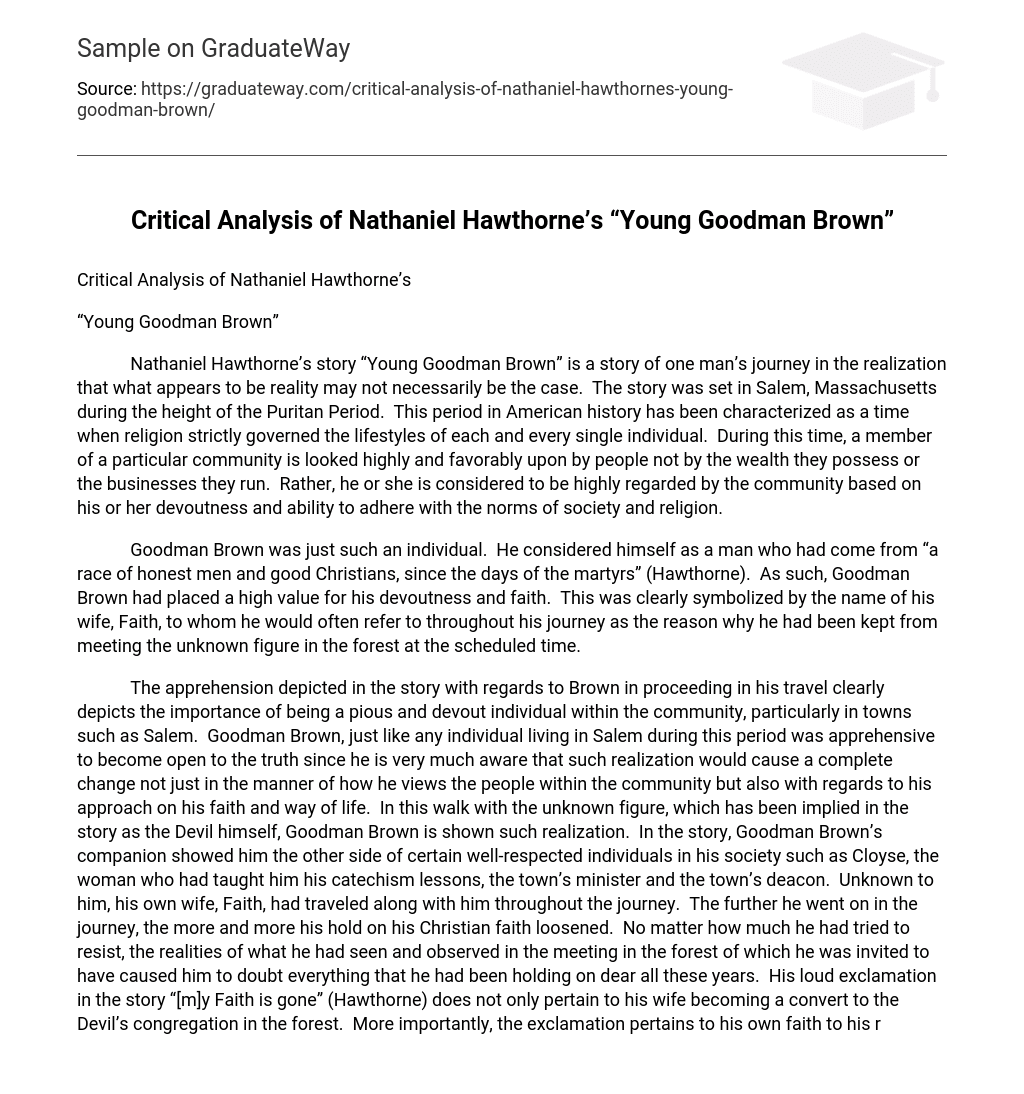Nathaniel Hawthorne’s story “Young Goodman Brown” is a story of one man’s journey in the realization that what appears to be reality may not necessarily be the case. The story was set in Salem, Massachusetts during the height of the Puritan Period. This period in American history has been characterized as a time when religion strictly governed the lifestyles of each and every single individual. During this time, a member of a particular community is looked highly and favorably upon by people not by the wealth they possess or the businesses they run. Rather, he or she is considered to be highly regarded by the community based on his or her devoutness and ability to adhere with the norms of society and religion.
Goodman Brown was just such an individual. He considered himself as a man who had come from “a race of honest men and good Christians, since the days of the martyrs” (Hawthorne). As such, Goodman Brown had placed a high value for his devoutness and faith. This was clearly symbolized by the name of his wife, Faith, to whom he would often refer to throughout his journey as the reason why he had been kept from meeting the unknown figure in the forest at the scheduled time.
The apprehension depicted in the story with regards to Brown in proceeding in his travel clearly depicts the importance of being a pious and devout individual within the community, particularly in towns such as Salem. Goodman Brown, just like any individual living in Salem during this period was apprehensive to become open to the truth since he is very much aware that such realization would cause a complete change not just in the manner of how he views the people within the community but also with regards to his approach on his faith and way of life. In this walk with the unknown figure, which has been implied in the story as the Devil himself, Goodman Brown is shown such realization.
In the story, Goodman Brown’s companion showed him the other side of certain well-respected individuals in his society such as Cloyse, the woman who had taught him his catechism lessons, the town’s minister and the town’s deacon. Unknown to him, his own wife, Faith, had traveled along with him throughout the journey.
The further he went on in the journey, the more and more his hold on his Christian faith loosened. No matter how much he had tried to resist, the realities of what he had seen and observed in the meeting in the forest of which he was invited to have caused him to doubt everything that he had been holding on dear all these years.
His loud exclamation in the story “[m]y Faith is gone” (Hawthorne) does not only pertain to his wife becoming a convert to the Devil’s congregation in the forest. More importantly, the exclamation pertains to his own faith to his religion as it is slowly tainted by skepticism and doubt on what many of the respected individuals in his communities show in public and what they do behind closed doors.
Hawthorne’s story “Young Goodman Brown” has been considered as a critical portrayal of the Puritan lifestyle exhibited in Salem during his lifetime. The story clearly defines that in spite of the members of the community displaying themselves as pious and extremely faithful to their religion by strictly adhering to the teachings of the Church and applying it in everyday life, this is not always the case.
The meeting in the forest symbolizes the private lives of each and every Puritan living during this period which is concealed from the public. Such immoral acts described by the Devil in the meeting are the reality that occurs out of the sight of the public which are considered to be extremely contrary to the norm of society.
Work Cited
- Hawthorne, Nathaniel. Young Goodman Brown. 2005. 29 December 2008. <http://www.wwnorton.com/college/english/litweb05/workshops/fiction/ hawthorne1.asp>.





